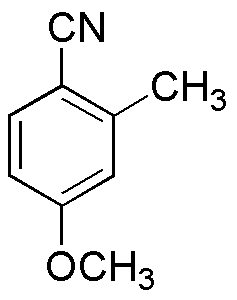2-Cyano-5-methoxytoluene is widely utilized in research focused on:
- Synthetic Chemistry: This compound serves as a key intermediate in the synthesis of various pharmaceuticals, allowing researchers to develop new drugs with enhanced efficacy.
- Material Science: It is used in the formulation of polymers and resins, contributing to the development of materials with improved thermal and mechanical properties.
- Organic Electronics: The compound plays a role in the production of organic semiconductors, which are essential for creating flexible and lightweight electronic devices.
- Agricultural Chemistry: It is involved in the synthesis of agrochemicals, providing solutions for pest control and crop protection, thereby enhancing agricultural productivity.
- Analytical Chemistry: This chemical is utilized as a standard in various analytical techniques, helping researchers ensure accuracy and reliability in their experimental results.
General Information
Properties
Safety and Regulations
Applications
2-Cyano-5-methoxytoluene is widely utilized in research focused on:
- Synthetic Chemistry: This compound serves as a key intermediate in the synthesis of various pharmaceuticals, allowing researchers to develop new drugs with enhanced efficacy.
- Material Science: It is used in the formulation of polymers and resins, contributing to the development of materials with improved thermal and mechanical properties.
- Organic Electronics: The compound plays a role in the production of organic semiconductors, which are essential for creating flexible and lightweight electronic devices.
- Agricultural Chemistry: It is involved in the synthesis of agrochemicals, providing solutions for pest control and crop protection, thereby enhancing agricultural productivity.
- Analytical Chemistry: This chemical is utilized as a standard in various analytical techniques, helping researchers ensure accuracy and reliability in their experimental results.
Documents
Safety Data Sheets (SDS)
The SDS provides comprehensive safety information on handling, storage, and disposal of the product.
Product Specification (PS)
The PS provides a comprehensive breakdown of the product’s properties, including chemical composition, physical state, purity, and storage requirements. It also details acceptable quality ranges and the product's intended applications.
Certificates of Analysis (COA)
Search for Certificates of Analysis (COA) by entering the products Lot Number. Lot and Batch Numbers can be found on a product’s label following the words ‘Lot’ or ‘Batch’.
*Catalog Number
*Lot Number
Certificates Of Origin (COO)
This COO confirms the country where the product was manufactured, and also details the materials and components used in it and whether it is derived from natural, synthetic, or other specific sources. This certificate may be required for customs, trade, and regulatory compliance.
*Catalog Number
*Lot Number
Safety Data Sheets (SDS)
The SDS provides comprehensive safety information on handling, storage, and disposal of the product.
DownloadProduct Specification (PS)
The PS provides a comprehensive breakdown of the product’s properties, including chemical composition, physical state, purity, and storage requirements. It also details acceptable quality ranges and the product's intended applications.
DownloadCertificates of Analysis (COA)
Search for Certificates of Analysis (COA) by entering the products Lot Number. Lot and Batch Numbers can be found on a product’s label following the words ‘Lot’ or ‘Batch’.
*Catalog Number
*Lot Number
Certificates Of Origin (COO)
This COO confirms the country where the product was manufactured, and also details the materials and components used in it and whether it is derived from natural, synthetic, or other specific sources. This certificate may be required for customs, trade, and regulatory compliance.


